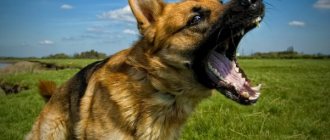Why does a dog twitch in its sleep?
Movement during sleep is absolutely normal, even for completely healthy dogs with a strong psyche. This is explained simply: the dog also dreams. One can only guess what the four-legged animal is dreaming from by its movements. If it moves its paws, it is probably chasing prey or running away from “enemies.” If she whines, it means she is being offended. Well, if it starts to slurp, it means that it has found something tasty.
In a dream, a dog can:
- lying on your side, move your paws;
- rotate the pupils with closed eyelids;
- move your ears;
- wag the tail;
- make different sounds: whine, bark, growl.
Dogs dream too
However, some movements during sleep may indicate illness in your pet. Therefore, you should carefully look at how he sleeps.
How to help a dying dog
To make it easier for your pet to pass away, you should observe how the dog behaves before death. A dog's behavior before death always changes, and an attentive, loving owner cannot fail to notice this. If a dog dies easily, then he needs nothing but peace and quiet, and sometimes the presence of his owner. Many dogs lick their owners' hands and wag their tails even in their last moments of life.
If dying is associated with the dog’s physical suffering, then the owner’s duty is to alleviate his condition and decide on euthanasia or consider all options for a worthy farewell to his final journey. This is not murder, as many people think, but the last help to someone who has been around for many years and who helped cope with everyday difficulties as best he could.
Euthanasia is necessary for animals dying from cancer, head injuries, multiple bleeding, or an incurable infectious disease. Only a veterinarian can perform this.
Dog dreams: myth or reality
Scientists answer this question unequivocally: dogs also dream. They began to seriously study this topic back in the middle of the last century, and now this issue has been studied as thoroughly as existing technology allows. It has been proven that, like humans, animals go through several stages of sleep: from light to deep. The latter is characterized by dreams.
A small area of the brain responsible for paralyzing muscles during sleep prevents both people and animals from “participating” in them in full force. It works differently for everyone: someone can sleep absolutely motionless, someone will definitely move. In dogs it is not so well developed, so the vast majority of animals move during sleep.
A dog goes through several stages of sleep: from light to deep.
The first experiments proving the presence of dreams in animals were carried out in the 50s of the last century, and now they would be considered inhumane. They removed part of the brain where the so-called “blue spot” was located.
By the way! The first animal to undergo this operation was a cat.
It is responsible for paralyzing the muscles during sleep. After such an operation, dogs during the deep phase jumped up, ran, played and even began to fight with imaginary enemies.
Interesting! Typically, dogs during such experiments continued to perform their duties during sleep. The hunters pursued the prey or called the owner to it. The guards barked loudly, protecting the territory. The exhibitors stood in a stance allowing one to evaluate their exterior.
Similar experiments are being carried out now, but without surgical intervention. Special medications allow you to temporarily “turn off” part of the brain. After participating in the experiments, the animals return to normal life.
Video - Why does a dog twitch and whine and sometimes bark in its sleep?
Why does a dog sleep with his eyes open?
Symptoms of illness in dogs can range from mild to severe. Many of them may disappear on their own, but not in an acute form. Symptoms such as loss of consciousness, seizures, difficulty breathing, high or low fever, and others are signs that your dog requires emergency veterinary care.
1. Loss of consciousness. The dog may suddenly lose consciousness; this may be preceded by trembling and convulsions. The dog stops responding to external stimuli and falls into a coma. She may shake her head and bite invisible objects.
2. Collapse. There are several signs of collapse.
How do dogs' dreams differ from human dreams?
With the advent of technology that allows one to monitor brain activity during sleep, experiments on dogs were continued. With their help, it was possible to prove that dog dreams are different from human dreams. They are brighter, more dynamic, and quickly replace each other. Thus, the deep sleep phase in a person can last about one and a half hours. During this time, he manages to view the whole story. In dogs, it takes on average 20-25 minutes, and the dream consists of 2-3 pictures that quickly replace each other.
Interesting! In small breeds of dogs, sleep phases alternate more often than in adults. So, in a toy terrier this can happen every 10 minutes, in a Great Dane - every hour.
Scientists are also inclined to believe that during sleep, animals can not only see and hear, but also smell. This is evidenced by the fact that they often twitch their nose in their sleep, as if sniffing at something.
In small breeds of dogs, sleep phases alternate more often than in adults
Do dogs dream?
Since we can't exactly ask our dogs if they can dream, and if so, what they dream about, science has come up with some interesting ways to determine whether dogs and other animals dream.
A 2001 study from the Massachusetts Institute of Technology (MIT) found that laboratory rats trained to run through a maze exhibited brain activity during rapid eye movement (REM) sleep similar to that when they were actually in the maze, resulting in researchers concluded that the rats were dreaming about the maze they had run into earlier.
In fact, their data was so specific that they could determine where in the maze the rat was daydreaming itself just by looking at the rat's unique signature of brain activity.
Since rats are less complex than dogs, it's safe to conclude that our dogs dream too.
We can't know exactly what dogs dream about because scientists haven't studied them as closely as they have studied rats, but researchers have noticed that certain breeds of dogs tend to engage in breed-specific behavior while sleeping. For example, Pointers, Pointers, and English Springer Spaniels exhibit blushing during REM sleep.
What do animals dream about?
So far no one has been able to “spy” on the dreams of animals. However, scientists have reason to believe that they are more diverse than we might imagine. Definitely, often a dream is a reflection of what has been experienced. Therefore, the central part of the plot is usually the owner, who is the center of the universe for the dog. Often dogs in which the “blue spot” was neutralized, in the active phase of sleep, did everything the same as during the day: played, followed commands, ran.
However, studies have shown that it is during sleep that ancient instincts manifest themselves in animals. Thus, even trained dogs, whose ancestors served humans for many generations, can begin to howl like wolves during the deep phase. And under the influence of drugs, they completely demonstrated original behavior: even decorative dogs could “go hunting” and demonstrate behavior characteristic of their ancestors in the pack.
During sleep, ancient instincts appear in an animal
Dogs have a third eyelid
Often when you see your dog's eyes open while sleeping, are they actually closed? Well, the truth is that you can see your dog's third eyelid. This is a light pink/red fabric that covers your dog's eyes to keep them moisturized even when they are sleeping and not blinking.
It's called a membrane that helps protect your dog's eyeballs. The gland located on it is responsible for 40-50% of your dog's tears. This membrane basically functions like a regular eyelid in that it also keeps debris from sticking to your dog's eyes. It also acts as a kind of windshield wiper blade to sweep foreign materials out of your dog's eyes since they can't rub their eyes very well the same way you and I do when we get something in our eye.
Do dogs have nightmares?
Fears are often reflected in dreams, including those of dogs. It is not difficult to understand that a dog is seeing a “bad” dream. In this case, the pet will whine, tuck its tail, desperately pound its paws and demonstrate anxiety in all sorts of other ways.
If such cases are isolated, you may not attach much importance to this. However, after severe stress, nightmares may recur. This is a signal to the owner that the animal feels insecure, and can subsequently result in health problems.
You can calm the animal by following simple rules:
- praise him more often, stroke him, talk, play;
- increase the time for an evening walk, but do not start active games and running around;
- Give mild sedatives to dogs.
Fears are often reflected in dog dreams
How can you tell if a dog is dying?
For any living creature, the process of dying occurs according to a scenario determined by nature. Dogs are no exception here. Here are the obvious signs that your pet will pass away in the next 24 hours:
Changes in breathing. The respiratory rate of an adult dog is 25-30 breaths per minute; in the last hours of life it is 10-12 breaths. The dog breathes shallowly and weakly. Gradually, his lungs stop filling, and they will relax for the last time after the pet dies.
Changes in heart rate. The pulse of a healthy adult dog is 80-120 beats per minute. In a dying dog it is approximately 50-60 beats. In the last minutes of life it is almost impossible to feel it, you can only hear it through a stethoscope or phonendoscope.
Complete refusal of food and water. The animal does not want to eat or drink, and has zero interest in treats. He no longer needs to support his body. Dehydration causes the nose and mucous membranes of the mouth to become dry and may peel and crack. It is useless to force water and feed; the dog either cannot swallow, or what he swallows causes an attack of vomiting. Droppers with nutrient solutions will also not have a resuscitating effect.
Vomiting, involuntary urination and involuntary stool, usually liquid. This happens because the dog does not control his body, all his muscles relax. People say that the animal has “purified itself.” Urine leaks almost constantly, and feces and vomit consist of mucus, sometimes mixed with blood. You shouldn’t scold the dog for this, he still won’t be able to restrain these processes, because he doesn’t feel the urge. It should be placed on absorbent diapers and periodically wiped with damp wipes.
Inability to stand on one's feet or inability to maintain a standing position. Owners often massage and place the pet on its paws, trying to restore sensitivity to its limbs. But all this is to no avail: the brain loses neural connections with muscles and ligaments and slowly dies.
Convulsive twitching and decreased sensitivity. In the last hours, even seriously ill dogs feel almost no pain. But there is no need to give up painkillers, since many diseases are accompanied by excessively severe pain syndromes, for example, cancer.
Loss or confusion of consciousness. The dog either does not react to stimuli at all, or reacts weakly and indistinctly. He no longer sees, does not hear, and probably does not smell, but all owners note that even a pet on the verge senses their presence and even tries to wag its tail.
Amyotrophy. It is observed in very old or long-term and seriously ill animals. The dog can’t hold his head up, his paws are moving apart, his mouth is half-open, and under the skin, instead of muscle knots, it feels like dense jelly.
Should you wake your dog during deep sleep?
Waking up in the stage of light sleep, the dog does not remember what it dreamed. However, if you wake her up during the deep stage, she will not immediately wake up from sleep. Most likely, in this case, you will look around for several seconds, as if not understanding where you are.
However, such an awakening can also be dangerous. A dog that “chased” enemies in a dream may growl, snap, or even bite its owner. This does not indicate hidden aggression, but only proves that in a dream, pets remember their instincts.
If nervous twitching and whining bother the owner, you can wake up the dog. However, you should not touch it. It's much safer to call her by name.
Dreams of puppies
Research has also shown that dogs have their first dreams while still in the womb. Therefore, it is not surprising that newborns can squeak and move in their sleep.
Dogs begin to have their first dreams while still in the womb
Puppy dreams last longer than in adult dogs. The active phase can take up to 90% of their sleep time. In addition, the children’s nervous system has not strengthened, so they may react more violently to dreams. They often begin to bark and whine, thereby waking themselves up.
In cases of such an “emergency” awakening, they may behave inappropriately for a few seconds: look around, not understanding where they are, continue whining, or even jump up sharply and run.
Interesting! Puppies can sleep with their eyes open. In this case, the pupils are covered with a thin film - the third eyelid.
This behavior worsens when moving to a new home. This is a lot of stress for the puppy, so the owner will have to show maximum understanding and patience while waiting for the puppy to adapt. Once this happens, his sleep will become more restful.
Why does a dog whine?
In most cases, the dog whines to attract attention, thereby achieving the fulfillment of its desires. In this way, the animal can beg for food while the owner is eating, or ask to go outside by hanging around the door. Moreover, it doesn’t matter what reaction comes from the owner, because even grumbling or punishment is also attention, albeit negative.
Animals may whine in response to stressful situations. Animals experience severe stress when separated from their owner, especially if there is a change of owner. Traveling by car can also be considered a stressful situation.
Easily excitable dogs can whine from overwhelming emotions, for example, in anticipation of an interesting game, a walk, the arrival of the owner, as well as when meeting another dog, if the pet is deprived of frequent communication with its own kind. This reaction is observed in dogs living in the yard of a private house, and some are very happy about contact with other dogs.
Some pets begin to whine to calm a person, for example, if he is depressed or in pain.
This behavior is observed in animals experiencing pain, such as constipation, when animals try to relieve themselves, but nothing happens. In bitches this behavior is observed during pregnancy. If a dog whines and trembles, then this condition indicates a strong pain reaction, the beginning of labor, and fear. If you notice signs of an animal's painful condition or injuries, you should immediately contact a veterinarian.
When interacting with people or other animals, pets may whine, feeling a threat to themselves or their owner, or, conversely, feeling fear and submission in the presence of a dominant individual or directed aggression of the owner.











